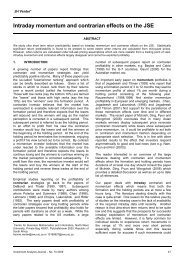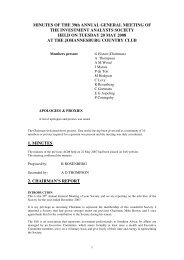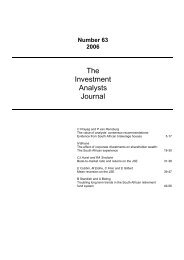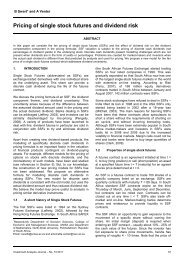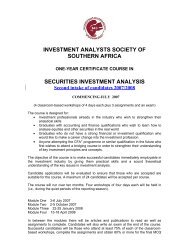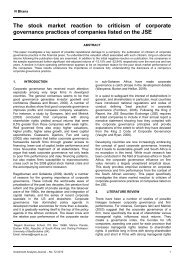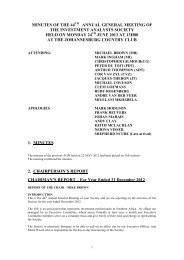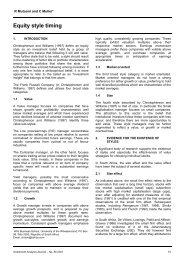Accounting is Broken - Investment Analysts Journal
Accounting is Broken - Investment Analysts Journal
Accounting is Broken - Investment Analysts Journal
Create successful ePaper yourself
Turn your PDF publications into a flip-book with our unique Google optimized e-Paper software.
Stern Stewart & Co.<br />
s h e e t—but neither one does. Accountants m<strong>is</strong>re p resent the true nature of pension assets<br />
and liabilities by only d<strong>is</strong>closing them in off-balance sheet notes.<br />
The true pension cost <strong>is</strong><br />
the present value of the<br />
extra re t i rement payments<br />
that employees<br />
have earned thro u g h<br />
their service to the company<br />
over the time period<br />
in question.<br />
Accountants also make a m<strong>is</strong>take in the way they re c o rd pension expense on corporate<br />
income statements. The true pension cost <strong>is</strong> the present value of the extra re t i rement payments<br />
that employees have earned through their service to the company over the time period<br />
in question. Putting it another way, the true pension cost <strong>is</strong> equal to the amount of cash<br />
that would have to be set aside and invested in a bond fund that would surely compound in<br />
value to meet the additional re t i ree payments 9 . Th<strong>is</strong> “service cost,” as it <strong>is</strong> known, dire c t l y<br />
i n c reases the firm ’s pension liability and decreases the firm ’s market value. It <strong>is</strong> the amount<br />
that should be subtracted as the periodic pension expense in the measurement of a firm ’s<br />
N O PAT and its EVA—but under present bookkeeping rules, it <strong>is</strong> not.<br />
Accountants and actuaries have concocted a complicated formula to measure a company’s<br />
pension expense:<br />
Pension Cost = Service Cost - ( Fund Return - Liability Interest )<br />
The pension expense <strong>is</strong><br />
the period-to-period<br />
i n c rease in the pension<br />
l i a b i l i t y, that <strong>is</strong>, in the<br />
p resent value of the<br />
p rom<strong>is</strong>ed re t i re m e n t<br />
benefits. It has nothing<br />
to do with the re t u rn s<br />
actually earned from the<br />
pension plan assets.<br />
The only way a company<br />
can be sure it will meet<br />
its pension commitments<br />
on schedule <strong>is</strong> to<br />
invest its pension fund<br />
assets in a diversified<br />
bond portfolio that<br />
matches the r<strong>is</strong>k pro f i l e<br />
of its pension liability.<br />
The bookkeepers start off on the right track by setting the pension cost equal to the serv i c e<br />
cost, but they err by subtracting the speculative spread between the re t u rn earned on the pension<br />
assets and the interest cost of the pension liability. The bookkeeping formula suggests that<br />
e a rning a higher re t u rn on pension fund assets reduces a company’s pension cost, but that <strong>is</strong> not<br />
at all correct. The pension expense <strong>is</strong> the period-to-period increase in the pension liability, that<br />
<strong>is</strong>, in the present value of the prom<strong>is</strong>ed re t i rement benefits. It has nothing to do with the<br />
re t u rns actually earned from the pension plan assets. Accountants once again inappro p r i a t e l y<br />
mix operating and financing dec<strong>is</strong>ions, and in the process they have lured many unsuspecting<br />
CFOs into gambling their shareholders’ equity on speculative investment re t u rn s .<br />
Given the priority the law accords pension beneficiaries—with justification after all—pension<br />
commitments ought to be d<strong>is</strong>counted to a present value at a very low interest rate, a rate even<br />
lower than the rate a firm would pay on its most senior debt. The firm ’s overall cost of capital<br />
<strong>is</strong> inappropriate for d<strong>is</strong>counting pension liabilities because it reflects the r<strong>is</strong>k of the re t u rn s<br />
f rom business operations. Nor <strong>is</strong> it correct to d<strong>is</strong>count pension prom<strong>is</strong>es at the rate of re t u rn<br />
expected from pension fund assets—that rate reflects the r<strong>is</strong>k of the re t u rns from those assets.<br />
The right rate to d<strong>is</strong>count the pension liability <strong>is</strong> the yield off e red by a portfolio of bonds<br />
that <strong>is</strong> one credit rating notch higher than the credit rating of the firm itself. A gilt-edged,<br />
Triple-“A” rated credit like GE should d<strong>is</strong>count its pension liability at the US govern m e n t<br />
bond rate of interest, and a Triple -“B” rated credit should use a Single-“A” interest rate—<br />
always one credit notch higher because the pension liability <strong>is</strong> senior to a firm ’s most senior<br />
l e n d e r s .<br />
Accountants do not follow th<strong>is</strong> course—although they are close. They uniformly d<strong>is</strong>count<br />
pension liabilities with a Double-“A” d<strong>is</strong>count rate (only truly applicable to Single-“A”<br />
rated credits). They understate the liability for big cre d i t w o rthy firms and overstate it for<br />
s m a l l e r, less credit capable ones. In the main, however, accountants do correctly acknowledge<br />
that pension liabilities are senior corporate claims that deserve d<strong>is</strong>counting at a re l a-<br />
tively low rate of intere s t .<br />
The only way a company can be sure it will meet its pension commitments on schedule <strong>is</strong> to<br />
invest its pension fund assets in a diversified bond portfolio that matches the r<strong>is</strong>k profile of<br />
its pension liability. Suppose a company has a $1 billion pension liability — the result of d<strong>is</strong>counting<br />
its re t i ree commitments to a present value at the prevailing Double-“A” bond yield<br />
of 7%. To neutralize the r<strong>is</strong>k to its shareholders, and align portfolio returns with pension<br />
9<br />
Pension fund consultants often stress that the liability should include the increases in benefits that would be due to future inflat<br />
i o n a ry increases, but that <strong>is</strong> incorrect. Almost all corporate operating costs, whether for materials or services or labor, will incre a s e<br />
due to inflation, and yet such increases are not re c o rded as current liabilities. In the economic model, the pension liability due to<br />
inflation will be re c o rded only as the inflation occurs and not in advance.<br />
11




